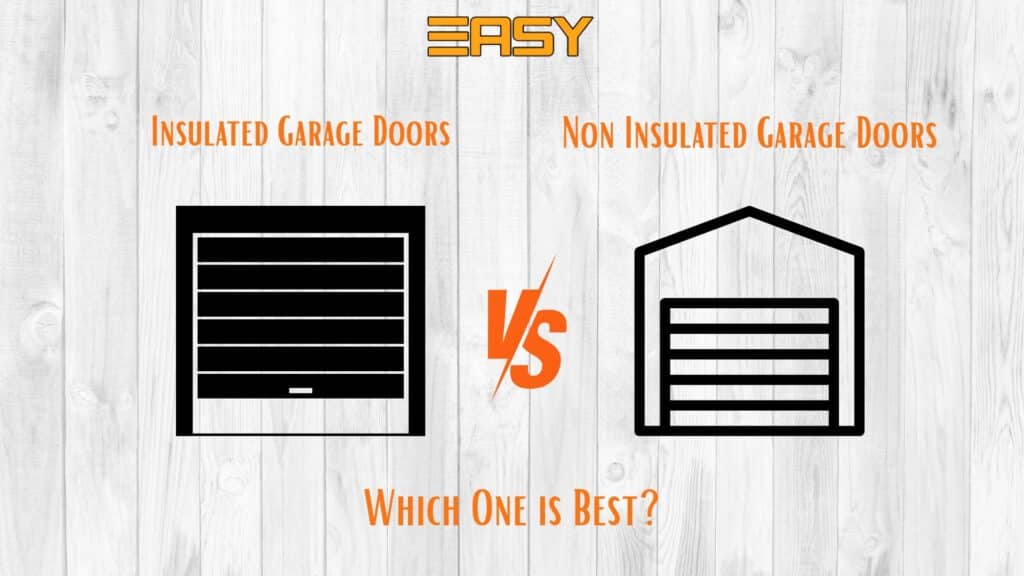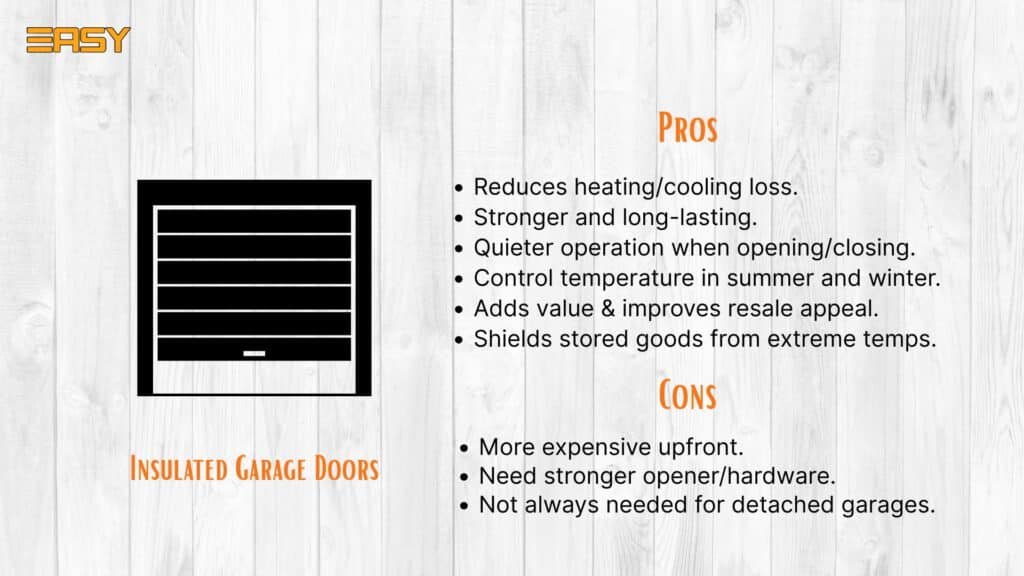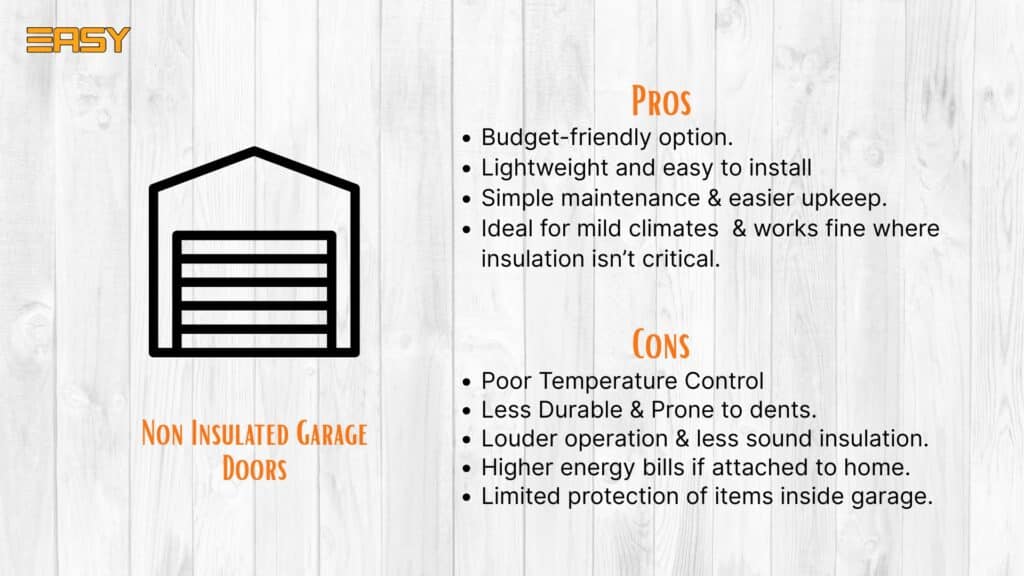
A simple decision, like the kind you make when picking the door to your garage, can have a huge effect on your coziness and your stuff’s living space. You might think that choosing between an insulated and a non-insulated garage door is a minor decision. After all, it’s just a door. But it’s a portal to your home in a way that very few other doors are. Your garage door plays a major role in your home’s security, low energy bills, and long-term comfort and savings.
But this is the thing: picking an insulated or uninsulated garage door is not as cut-and-dried as you might assume. Your garage door is almost certainly the biggest movable part of your house, and if it isn’t insulated, it might be throwing away energy at a rate that could be costing you hundreds of dollars a year.
If, on the other hand, your garage door is insulated, let’s take a moment and compare insulated vs non-insulated doors, and examine how that might or might not be affecting your energy bills!
What is Insulation in Garage Doors?
Insulation acts as a protective barrier or material that’s meant to regulate temperature. In a garage attached to a house, poor insulation around the door can let the cold winter air seep in, as well as the warm summer air, if the garage door is not properly sealed. When the house and the garage are sharing a wall, poor insulation in the door can allow the outdoor temperatures to come into the interior. The good news is that an insulated garage door can maintain the space around 10 to 14 degrees warmer than the outdoor temperature in the winter and around 22 to 26 degrees cooler in the peak of summer.
Types of Garage Door Insulation
The primary two types of insulation used by most garage door makers are polystyrene and polyurethane. Each has its advantages, and the best choice for the door depends on the user’s budget, the climate where they live, or whether they aim to save energy.
1. Polystyrene Insulation
The budget-friendly option is polystyrene foam, which offers decent insulation with R-values around 3.6 to 4.4. This is similar to the foam used in coolers. It’s cut and fitted into the panels of the garage door. It provides a decent level of thermal resistance, and it is more affordable. But because it’s layered in rather than injected, it doesn’t seal every gap.
Best for: Mild climates or detached garages
Drawback: Less effective in extreme heat or cold
2. Polyurethane Insulation
The premium option is polyurethane foam, which is injected between the layers of the door, where it expands and hardens. This material can yield R-values ranging from 6.5 to 18.4, not to mention that it makes the door extremely strong and stiff.
Best for: Energy efficiency, strength, quieter operation
Drawback: Slightly more expensive
Understanding R-Value in Garage Doors
R-value indicates how effectively a material resists the flow of heat. The higher the R-value means the better insulated the door. Think of it this way:
- An R-6 door is like wearing a light jacket in the cold.
- An R-18 door is like wearing a heavy-duty winter coat.
Here’s a brief comparison of R-value ranges in garage door insulation:
| Energy savings, extreme climates, and attached garages | R-Value Insulation Type | Best For |
| Non-insulated | R-0 | Sheds or garages with no temperature concerns |
| Polystyrene (single-layer) | R-3 to R-5 per inch | Mild climates or budget-conscious installs |
| Polyurethane (double-layer) | R-7 to R-18+ per inch | Energy savings, extreme climates, attached garages |
What are STC Ratings and Why Do They Matter?
STC stands for Sound Transmission Class. It measures how well a material blocks sound. While not every homeowner thinks of this at first, garage door insulation can help reduce outside noise. It’s a big plus if your garage faces a busy street.
Here’s what STC ratings typically look like:
| STC Rating | Noise Control Level |
| 25-30 | Basic – blocks light conversations |
| 30-35 | Moderate – muffles street noise |
| 36-40+ | High – good for busy urban areas |
Comparative Analysis of Insulated vs Non-Insulated Garage Doors
When deciding between insulated and non-insulated garage doors, it’s not just about how they look. It’s about how they function, how much they save costs, and how they fit into your lifestyle. Here’s a side-by-side breakdown to help you make a smart decision based on your needs.

Benefits of Insulated Garage Doors
- Temperature Control: Temperature buffer between garage and outdoors. Reduced heating and cooling workload on your home. Lower utility bills.
- Comfortable Indoor Climate: The garage space remains warmer in the winter and cooler in the summer, even without an HVAC system.
- Reduced Noise: A door that is insulated keeps out a lot of street noise and reduces the vibration you feel when you open or close the door. If you live on a busy road, this is such a nice upgrade that you wouldn’t understand its virtue unless you had experienced the poor version of it.
- More Durable: The majority of insulated doors are composed of several layers of material. These commonly include a steel or aluminum skin on both sides. This gives the doors a lot more resistance to being damaged.
- Storage Protection: An insulated door helps keep those items in better condition for longer. It is best to store anything sensitive to extreme temperatures, like paint, batteries, tools, or electronics.
- Premium Appearance: Installing a garage door that is insulated typically returns 70 to 80 percent of its cost when you sell your home. That’s one of the best returns on investment for any home improvement project. Plus, it just looks better. Insulated doors have a kind of premium appearance that shouts “I take care of my home” to potential buyers.
Cons of Insulated Garage Doors
- Higher Upfront Cost: Garage doors that have insulation are pricier than those that do not. If you want an insulated door, be prepared to spend around $1,500 or more. The Type of insulation you have, along with the door’s basic materials, can affect the final price of an insulated garage door, too.
- Heavier Weight: With added insulation comes more weight. It requires a more powerful opener and stronger springs, especially in an older system or when operating the door manually.
- Limited Need for Detached Garages: If your garage is not connected to your home and you rarely spend time in it, insulation might not be necessary. In that case, the added cost may not bring enough benefit.

Benefits of Non-Insulated Garage Doors
- Lower Initial Investment: The least expensive choice you have for garage doors are non-insulated garage doors. These doors are very budget-friendly and serve well for homeowners who need a fast replacement. They also work great for families that are trying to save some money.
- Lightweight and Easy to Use: Constructed from steel or aluminum, these doors carry a light weight. This lightness translates to less energy needed to open and close them; hence, they could last longer than some other garage doors. Their halves (or panels, as they’re sometimes called) occupy less space, and when you think about it, we call these doors sectional garage doors for a reason.
- Sufficient for Detached Garages: Doors lacking insulation are ideal for detached garages and other circumstances where the climate is mild and only changes seasonally. They are also somewhat the standard for tool sheds and storage spaces.
- Budget-Friendly:If you choose a door that is not insulated, you are saving money. You are saving quite a bit of money, actually. You’re saving somewhere between $200 and $800. That’s serious cash that you could use for other projects around your house.
Cons of Non-Insulated Garage Doors
- Poor Temperature Control: Without insulation, your garage becomes a direct extension of the outdoors. That means freezing temperatures in winter and blistering heat in summer. This is a big disadvantage, especially for Houston’s heat.
- No Sound Barrier: In a house built with metal-on-metal construction, you’ll hear every sound made by traffic, neighbors, and doors. For homeowners who prize quiet, this can be a reason to look elsewhere.
- Flimsier Build: Doors that are not insulated typically have only one layer. This makes them much more prone to warping and denting over time.
- Reduced Longevity: Doors that are not insulated are less protected from the weather. In time, the swings in temperature and the presence of moisture can wear them down. They can survive some time like this; however, it’s pretty likely that they won’t last as long as an insulated door would under the same conditions.
Insulated vs Non-Insulated: Comparison Table
| Feature | Non-Insulated Door | Insulated Door |
| Installation Cost Range | $600 – $1,500 | $1,000 – $2,500 (up to $4,000 premium) |
| Energy Savings (Annual) | $0 | ~$100/year (conservative estimate) |
| Break-Even Time | – | ~6 years |
| Estimated Energy Savings Over 20 Years | $0 | ~$2,000 |
| Maintenance Needs | Higher | Lower |
| Expected Lifespan | Shorter | Longer |
| Impact on Home Value | Minimal | Positive boost |
| Best For | Detached garages, low budgets | Attached garages, energy efficiency, and resale value |
Making the Right Choice: Insulated vs Non-Insulated Garage Doors
Go with an insulated door if you check any of these points:
- Your garage is attached to your house (this is the big one),
- You want to minimize your cooling costs during those long Houston summers,
- If you use your garage for anything besides parking, you have living space above or next to the garage.
- You store temperature-sensitive items (like your craft beer collection),
- Noise is a concern if you’re planning to sell within the next decade in Houston’s competitive real estate market.
Basically, if you answered yes to having an attached garage in Houston, you should probably get an insulated door. It’s that simple for most people in Southeast Texas.
Non-insulated might work if your garage is detached and you only use it for parking and basic storage, you’re extremely budget-constrained after that property tax bill, or you’re planning major renovations soon that will include the garage anyway.
Choosing Your Door: The Practical Stuff
Once you’ve decided on insulated, you’ll need to pick the right level of insulation. For Houston’s hot and humid climate, an R-value of 9 to 12 is usually recommended. If your garage faces west and gets that brutal afternoon sun, go for R-12 or higher.
Trust your insulated garage door installation process to Easy Garage Door Repair. Our professionals will handle the entire process, starting from answering the basic questions to the installation. With over 5 years of serving Houston homeowners, we know the unique challenges our Gulf Coast climate presents for garage doors. Our technicians are factory-trained specialists who can guide you through selecting the perfect insulation rating for Houston’s sweltering summers and occasional cold fronts.
Most installations are completed in a single day, causing minimal disruption to your busy schedule, and we offer flexible appointment times to accommodate Houston’s diverse workforce. Every installation includes a comprehensive warranty and a follow-up inspection to ensure your new insulated door is performing efficiently in your specific neighborhood conditions. Call us at 832-570-3845 today for a free consultation and join thousands of satisfied Houston homeowners enjoying the comfort and energy savings of properly installed insulated garage doors.








